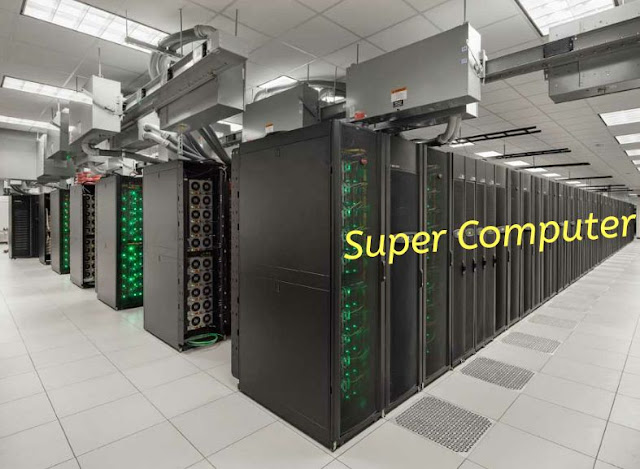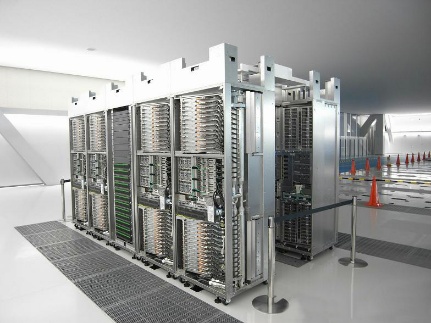What is a supercomputer? We all know about computer but do you know about supercomputer? This is the super version of Computer And it is also true that such a device is called a supercomputer. Which makes processing better and faster than all existing computers.
If we talk of earlier times, then vaccum tubes and transistors were used in computers and computers used to come in large rooms. But since the time of Integrated Circuit or microchips came, now the size of computers has reduced to a great extent.
But their processing speed is thousands of times faster than all other normal computers.
Here in this article today, we will know what is Supercomputer, History of Supercomputer, How powerful are supercomputers?, Advantages and disadvantages of Supercomputers.
Then without further delay, let's start.
What is Supercomputer
The supercomputer is the world's most powerful computer used in the processing of complex mathematical and scientific calculations and high-level computing. Its performance is measured in FLOPS rather than MIPS. A supercomputer has thousands of CPUs that count billions simultaneously in a second.
Speaking of computers, it is a general-purpose machine that takes information (data) through an input process, stores them and then processes them as needed, and eventually produces some type of output. is.
Supercomputers have much more functionality than general purpose computers. And the speed is also millions of times more so that complex mathematical calculations and equations can be solved in real time.
Thousands of CPUs work together in a supercomputer. Therefore, multitasking is a common feature of supercomputers. Because, they have been developed to handle multiple tasks simultaneously.
Supercomputers operate on the principle of parallel and grid processing rather than serial processing. So instead of doing one thing at a time, it does many things at a time.
Most supercomputers are used for scientific and engineering applications to handle large databases as well as perform large amounts of computational operations. In terms of performance, it works thousands of times faster and more accurately than a normal computer.
Supercomputer performance is measured in FLOPS, which means floating-point operation per second. Therefore, the more FLOPS a computer has, the more powerful it is.
How Powerful Are Supercomputers?
If we talk about normal computers, then MIPS (million instructions per second) is used to measure their computing speed. By which fundamental programming commands such as read, write, store etc. are managed by the processor. To compare two computers, their MIPS are compared.
But the way to rate supercomputers is slightly different. Since most scientific calculations are done in this, they are measured by floating point operations per second (FLOPS). Let us see the list made according to this FLOPS.
| Unit | FLOPS | Example | Decade |
| Hundred FLOPS | 100 = 10 power 2 | Eniac | ~1940s |
| KFLOPS (kiloflops) | 1 000 = 10 power3 | IBM 704 | ~1950s |
| MFLOPS (megaflops) | 1 000 000 = 10 power 6 | CDC 6600 | ~1960s |
| GFLOPS (gigaflops) | 1 000 000 000 = 10 power 9 | Cray-2 | ~1980s |
| TFLOPS (teraflops) | 1 000 000 000 000 = 10 power 12 | ASCI Red | ~1990s |
| PFLOPS (petaflops) | 1 000 000 000 000 000 = 10 power 15 | Jaguar | ~2010s |
| EFLOPS (exaflops) | 1 000 000 000 000 000 000 = 10 power 18 | ????? | ~2020s |
History of Supercomputer
If you study the history of computers, then you will find that no one individual has contributed to it, but many people have given their contribution from time to time. Then we got to see such amazing machines.
But when it comes to Supercomputer, then a huge credit goes to Seymour Cray (1925–1996). Because his contribution is highest in Supercomputer. You can also call them the father of a supercomputer.
1946: John Mauchly and J. Presper Eckert created ENIAC (Electronic Numerical Integrator and Computer), University of Pennsylvania. It was the first general-purpose, electronic computer, it was about 25m (80 feet) long and about 30 tons its weight. It was created to operate military-scientific problems and was the first scientific supercomputer.
1953: IBM developed the first general-purpose mainframe computer, named IBM 701 (also known as Defense Calculator), and sold about 20 machines to different government and military agencies The 701 was the first off-the-shelf supercomputer. Gene Amdahl, then an engineer at IBM, later redesigned it and named the upgraded version IBM 704, a machine that had a computing speed of around 5 KFLOPS (5000 FLOPS).
1956: IBM then developed the Stretch supercomputer for Los Alamos National Laboratory. It has been the world's fastest supercomputer for nearly 10 years.
1972: Cray abandons control data and sets up Cray Research to build high-end computers.
1976: First Cray-1 supercomputer installed at Los Alamos National Academy. Whose speed was 160 MFLOPS.
1979: A faster Cray computer was developed by Cray-1 after Cray-1. Which could perform calculations in speeds of 1.9 GFLOPS with eight CPUs. In Cray-2, the length of the wires decreased from 120 cm to 41 cm. That is, Cray has proved his C-Shaped Supercomputer concept.
1983: Thinking Machines Corporation then manufactured the massively parallel Connection Machine, in which about 64,000 parallel processors were used.
1989: Seymour Cray formed a company called Cray Computer to manufacture Cray-3 and Cray-4.
1993: Fujitsu Numerical Wind Tunnel with 166 Vector Processors became the world's fastest supercomputer.
1995: Cray Computer also started drowning in financial difficulties, so he filed a case of bankruptcy protection. Simultaneously, Seymour Cray died in a road accident on October 5, 1996.
1996: Cray Research (Cray’s original company) was purchased by Silicon Graphics.
1997: Supercomputer is built by Intel with Pentium processors and Sandia National Laboratories becomes the world's first TFLOPS supercomputer.
2008: Jaguar Supercomputer developed by Cray Research and Oak Ridge National Laboratory became the world's first petaflops (PFLOPS) supercomputer. Which was later defeated by companies in Japan and China.
2011-13: Jaguar was extensively (and expensively) upgraded, and renamed Titan, and later became the world's fastest supercomputer, which was later downgraded by the Chinese machine Tianhe-2.
2014: European Consortium named Mont-Blanc announced the creation of an ExaFLOP (1018 FLOP) supercomputer from smartphones and tablets.
2017: Scientists of China announced to present the Nampla of Exaflop supercomputer.
2018: IBM Summit 200-petaflop supercomputer installed at Oak Ridge in June 2018. Which remains the world's most powerful and fastest supercomputer till date.
World's fastest Supercomputer
There is a lot of competition in all countries about computing power, which can be at the forefront, but the top position is the same. Peak performance in supercomputing always varies. Even in the definition of supercomputer, it is written that it is a machine "which always works at its highest operational rate."
Due to the competition, it makes supercomputing more interesting, so that scientists and engineers always continue their research on better computational speed. LSo let's know the top 5 supercomputers in the world are from cones.
- IBM Summit
- Sunway TaihuLight (China)
- IBM Sierra
- Tianhe-2
- Titan
- Piz Daint
Which Operating System is used in Supercomputers?
You may be surprised to know that ordinary operating systems are used to run supercomputers that we run on our PCs, but we know that more modern supercomputer actuals include off-the-self comouters and workstations. Are clusters of
Until a few years ago, Unix was used according to the operating system, while Linux is still used in its place. Which is open-source. Since supercomputers generally work on scientific problems, their application programs are written in traditional scientific programming languages such as Fortran, or more popular modern languages such as C and C ++.
Functions of Supercomputer :-
- Weather forecasting
- Climate Research
- Physical Simulations
- Nuclear Energy Research
- Genetic Analysis
- Animated Graphics
- Code Breaking
- Quantum Mechanics
- Molecular Modeling
- Fluid Dynamic Calculations
- Oil and Gas Exploration
Advantages of Supercomputers
- It is able to solve the biggest problemsin a pinch.
- It can also save a lot of your assets.
- You can also do virtual testing with it.
Disadvantages of Supercomputers
- It can be very expensive.
- It uses a lot of space.
- Very skilled craftsmen are required.
- It costs a lot to repair it.
- This can only work for select tasks.
Conclusion
I hope you have liked my article What is Supercomputer? - all impormation
If you liked this post What is Supercomputer? or got to learn something, then please share this post on social networks such as Facebook, WhatsApp, Pinterest, LinkedIn and Twitter.
Tags: What is supercomputer, Supercomputers, history of supercomputer, Functions of Supercomputer, World's fastest Supercomputer, advantages and disadvantages of supercomputers.













0 Comments